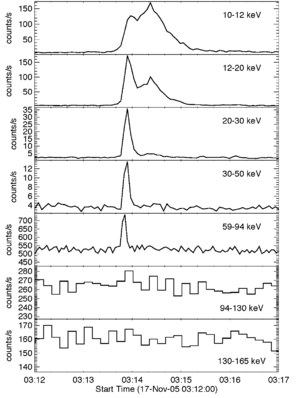Gamma rays and Doppler shifts
From RHESSI Wiki
| Nugget | |
|---|---|
| Number: | 155 |
| 1st Author: | Hugh Hudson |
| 2nd Author: | |
| Published: | 13 June 2011 |
| Next Nugget: | TBD |
| Previous Nugget: | [http://sprg.ssl.berkeley.edu/~tohban/wiki/index.php/Acceleration_Without_Heating |
| List all | |
Introduction
This is a third Nugget on a single interesting flare, and probably not the last. See "Black and white flares" and "At last, the EUV Spectrum!". This particularly nice and very impulsive flare, SOL2010-06-12T00:57 in the new IAU naming scheme, was the first gamma-ray flare of Cycle 24, and in this Nugget we ponder the possible relationship between this fact and our new capability, using [EVE], to study Doppler shifts.
What links gamma rays and Doppler shifts?
The simple answer could be "momentum". At the present time many options remain open for energy transport within solar flares. Large-scale transport is necessary because, given what we know about flare energetics, the flare energy supply is in the corona and its sink is in the chromosphere. If there is an accompanying CME, then "mechanical luminosity," ie the ejection of physical matter beyond the reach of solar gravity, also plays an important role.
The candidates for this energy transport include ordinary thermal conduction, particle beams (electrons, ions, or neutral), and plasma waves via their Poynting flux. But, with energy flux also goes momentum flux. Momentum must be conserved, according to Newton. The interesting point raised here, alas with no adequate conclusion, is that these processes for energy transport have different consequences for momentum transport. Ion or neutral beams, for example, contain of order mp/me/ ~ 2 x 103 more momentum than an electron beam with the same energy.
If we regard Figure 1, we see a simple mechanical analog of a CME ejection. The CME (represented here by a cannonball) flies away from the Sun, but its compensating momentum remains behind to displace the body of the Sun ever so slightly.
Gamma-rays and He II during the flare's impulsive phase
| RHESSI Nugget Date | 13 June 2011 + |
| RHESSI Nugget First Author | Hugh Hudson + |
| RHESSI Nugget Index | 155 + |
